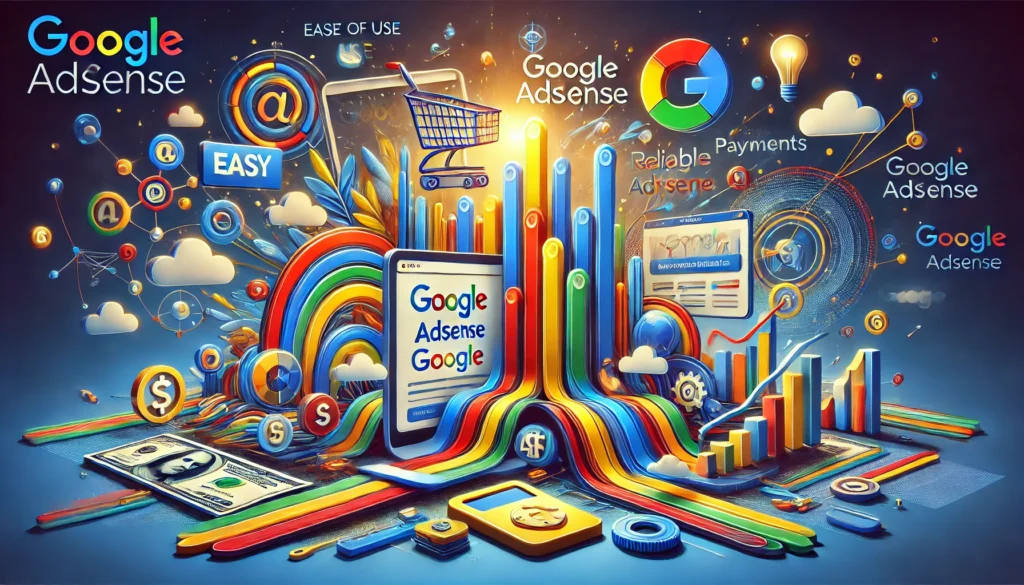
In the great expanse of the digital age, monetization strategies have become the lifeblood of content creators and website owners. It provides the necessary fuel to survive and grow their online ventures. Google AdSense, a program that converts ordinary site traffic into significant cash, is key to this digital monetization revolution. This platform not only allows publishers to make money from their interests, but it also links marketers to their target audiences with unparalleled precision. At the end of the article, you will learn a detailed summary of everything you need to know about Google AdSense.
What is Google AdSense?
Google AdSense is a Google service that enables publishers in the Google Network of content sites to show automatic text, image, video, or interactive media adverts based on the site’s content and audience. This program is beneficial for both publishers looking to monetize their websites and advertisers seeking to advance their products effectively. Google AdSense stands out as a leading product, providing a simple yet effective approach to generate cash from online content.
Requirements for Google Adsense on Website
To participate in the Google AdSense program and start monetizing your website, you must first meet Google’s eligibility standards. These standards are intended to guarantee that both advertisers and users have a positive experience, and that the advertisements presented are effective and appropriate. The following are the key conditions for your website to qualify for Google AdSense:
- You must be over 18 years of age.
- You must own and control your website.
- Your website should have unique and interesting content, not copyrighted content.
- It should have clear navigation and avoid fake traffic.
- Your content must comply with Google’s content policies.
- You must use a Supported Language.
- Your site must not provide an abusive experience.
- You should have technical pages.
- You need enough traffic.
Setting Up Google AdSense
Setting up Google AdSense is a simple process that integrates easily into almost any website, allowing publishers to begin selling their content with minimal effort. Always remember that the success of your AdSense account is closely tied to the quality and engagement of your website’s content. Here’s a step-by-step guide for setting up Google AdSense:

Step 1: Meet the Requirements
Before applying, you have to be sure your website adheres to Google’s AdSense policies and guidelines. This includes having a website with substantial, original content that is family-friendly and accessible to users.
Step 2: Apply for AdSense
Create a Google Account. If you don’t already have one, you’ll need a Google account to access AdSense. Then you must go to the Google AdSense website and click on the “Sign Up Now” button. Enter Your Website Information that is provide the URL of the site you want to monetize. After that, enter your payment address and other personal information.
Step 3: Connect Your Site to AdSense
Once your application is approved, you’ll receive an AdSense code. After receiving, paste the Code on Your Site. This HTML code must be pasted into the HTML of your website. You’ll need to place it on every page where you want advertisings to appear or in the template.
Step 4: Configure Your Ads
Decide on the types of ads you want and where on your page you’d like them to show. Google offers a variety of ad formats including banners, skyscrapers, and rectangles. You should aslo customize the color scheme and style of the ads to better fit your website’s design.
Step 5: Optimize and Monitor Your Ads
Use the AdSense dashboard to track how your ads are doing in terms of clicks, impressions, views and earnings. Optimize Ads for Better Performance. You must experiment with different ad placements and formats to find the combinations that lead to the best performance.
Setting up Google AdSense is just the beginning. The real work involves monitoring and adjusting ads to optimize revenue while maintaining a positive user experience on your platform. Regular experimentation and modifications based on performance statistics are essential to maximize Google AdSense profits.
How Google AdSense Works
First of all, Google has to approve your website. Google does not publicly share its approval numbers. However, if your site contains unique content and adheres to AdSense’s policies, you are able to apply. You must be 18 years or older. You can also take a look at “How to Get AdSense Approval” to avoid problems about getting approval. Once approved, you can set up adverts to show on your platform. You can specify which types of adverts show and where on the page. However, the companies that appear on your website bid for the privilege to be there.
Google AdSense operates on a simple structure: it allows website owners and bloggers to create space on their sites for ads and earn money when visitors interact with these ads. It is a part of Google’s larger advertising network, utilizing the same infrastructure and ad inventory available to Google Ads.
Publishers integrate AdSense code on their website pages. This code acts as a placeholder for advertisements. Using advanced algorithms, Google then displays ads that are relevant to the content of the page or the interests of the viewer. This relevancy, which is also known as Ad Matching matters since it enhances the possibility that viewers will interact with the adverts.
Revenue Models in Google AdSense
Google AdSense allows advertisers to compete for space on your website based on both your content and the likelihood that visitors will click on their adverts. Google determines the latter based on the advertiser’s “quality score.” There are two understandings here:

- One is the Cost-Per-Click, or CPC. This is the percentage of visitors to your platform that Google thinks will click on advertisements. Another factor is ad relevancy, or how well an ad matches user intent.
- Another is Cost-Per-Impressions, or in briefly, CPI. It’s based on how publishers earn based on the number of impressions their ads receive, regardless of clicks.
These approaches are intended to enhance publishers’ earning potential while ensuring that advertisers obtain a return on their investment by targeting advertising to likely interested users.
How Much does Google AdSense Pay on Website?
Advertisers determine what they’re willing to pay per ad click on your site by considering various factors and setting a cost per click (CPC). Imagine your website as a landscape painting at an auction, attracting collectors. The quality of your painting increases the competition among buyers, potentially raising its value.
Although Google doesn’t disclose all its metrics for determining earnings, consider this scenario: your website receives 2,000 visits in a month and 1.5% of visitors click on an ad, resulting in 30 clicks. If the CPC set by advertisers is 75 cents, you could earn about $22.50 from those clicks in that month.
How to Maximize the Effectiveness of Ad Placement
To maximize the effectiveness of ad placements, Google AdSense uses sophisticated targeting technological advances to match the relevant ads with the appropriate content and audience. Here’s an expanded look of Google’s strategies:
Contextual targeting: It analyzes the text of a website to establish its subject matter and then displays advertisements that are closely connected to that material. This approach utilizes natural language processing and keyword analysis to guarantee that advertising are not only relevant, but also provide value to the user’s experience. By matching adverts to material that a user is already interested in, the likelihood of engagement increases. This relevancy also contributes to the integrity of the user’s browsing experience, making adverts appear less intrusive and more like a natural part of the content.
Interest-Based Targeting: It’s also known as behavioral targeting, uses information about the user’s past browsing behavior to fit ads to their interests. Data is acquired from a user’s activity on numerous websites that use Google’s advertising services. This method ensures that visitors see adverts that are relevant to their overall interests, instead of just the content of a particular page.
Placement Targeting: This feature enables advertisers to select specific websites inside the Google AdSense network where they want their adverts to display. This method is commonly employed when advertisers want to target a specific demographic, specialized market, or audience type and know which websites they visit. Advertisers can more efficiently reach their intended audience, while publishers can attract higher-paying advertising that are better suited to their area. This relevance may boost the user experience while potentially increasing income for publishers.
Benefits of Google AdSense
Google AdSense offers several advantages that make it a popular choice for website owners looking to monetize their content. Let’s take a look at some of the key benefits:

- Ease of Use: Google AdSense is popular for its simplicity and ease of integration. Publishers may easily sign up, and once approved, they just copy and paste the given code into their website to get started showing ads. This simplicity enables even individuals with limited technical knowledge to efficiently use AdSense.
- Reliable Payments: AdSense has an international reputation for paying publishers on time and reliably, as long as they meet the minimal level. This reliability makes it an appealing alternative for publishers wishing to generate consistent revenue from their online content.
- Cost-Effectiveness: AdSense ads are frequently pay-per-click (CPC), allowing advertisers to pay only when a user interacts with their ad, making them cost-effective. This means that publishers can earn revenue every time a visitor clicks on the adverts presented on their website.
- Targeted Ads: AdSense advertising is customized based on the site’s content and audience. Google’s algorithms automatically display adverts that are relevant to the website’s visitors or their search history. This raises the likelihood of ad interaction, boosting publisher earnings and ad effectiveness for advertisers.
- Access to a Large Advertising Network: AdSense publishers get access to Google Ads’ massive network of advertisers. This means that multiple kinds of advertising may be shown that are relevant to various types of content, boosting the likelihood of clicks and income.
- Customizable Ad Features: Publishers can decide where advertising display on their website, what types of ads are allowed, and even prohibit unwanted ads. They can also change the appearance and feel of text adverts to match their website.
- Comprehensive Reporting Tools: AdSense’s extensive reports enable publishers to track ad performance, page visits, click-through rates, and earnings. These information are critical for optimizing campaigns and increasing ad revenue.
- Support for Multiple Platforms: AdSense supports multiple platforms, including mobile apps and YouTube videos, in addition to websites. This adaptability enables publishers to monetize a variety of content categories across several channels.
Conclusion
Google AdSense is a powerful tool for digital monetization that precisely balances the needs of advertisers with the earning objectives of publishers. Publishers can use this platform to turn their digital spaces into profitable companies. Anyone interested in online content monetization must first understand how AdSense works. As digital content grows, AdSense is likely to keep playing an important role in the online advertising ecosystem, adapting to new technological advances and market demands.
If you have any questions or need further assistance with Google AdSense, please feel free to contact us.